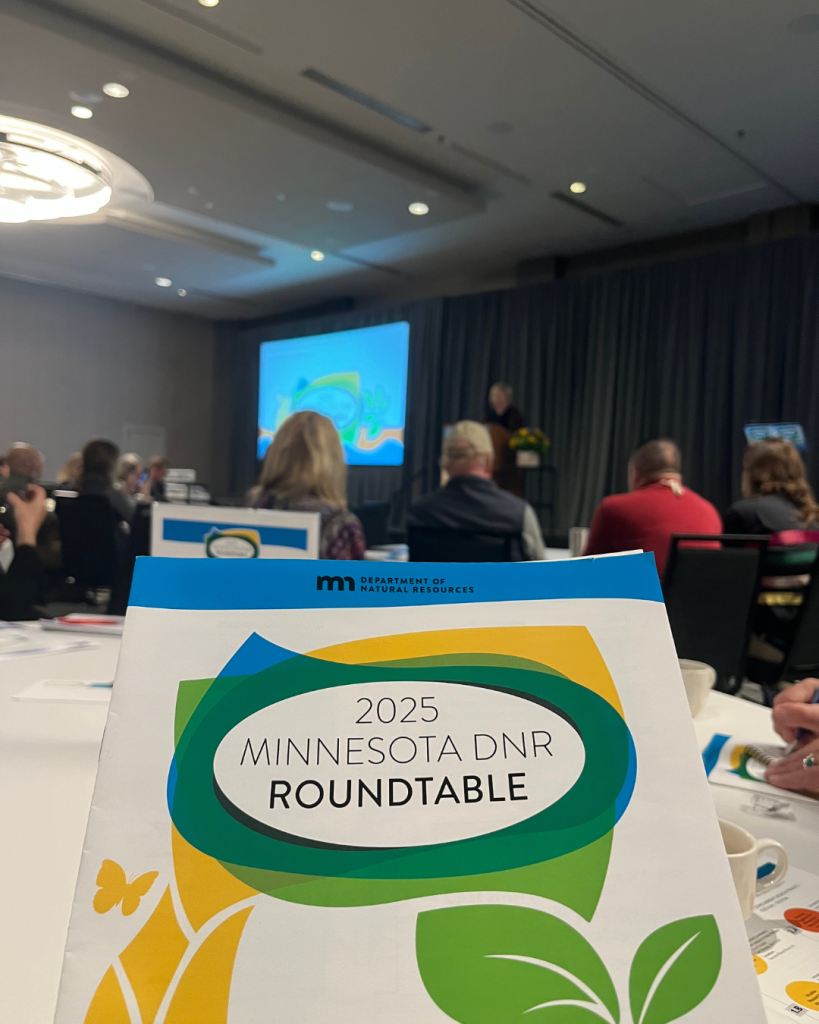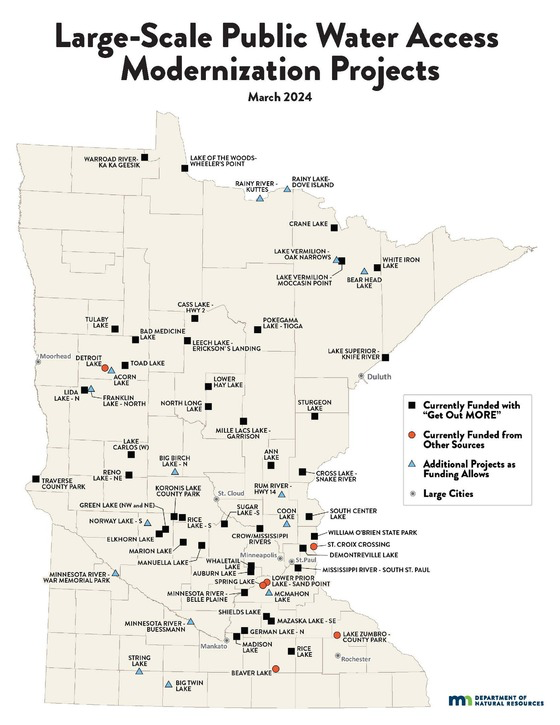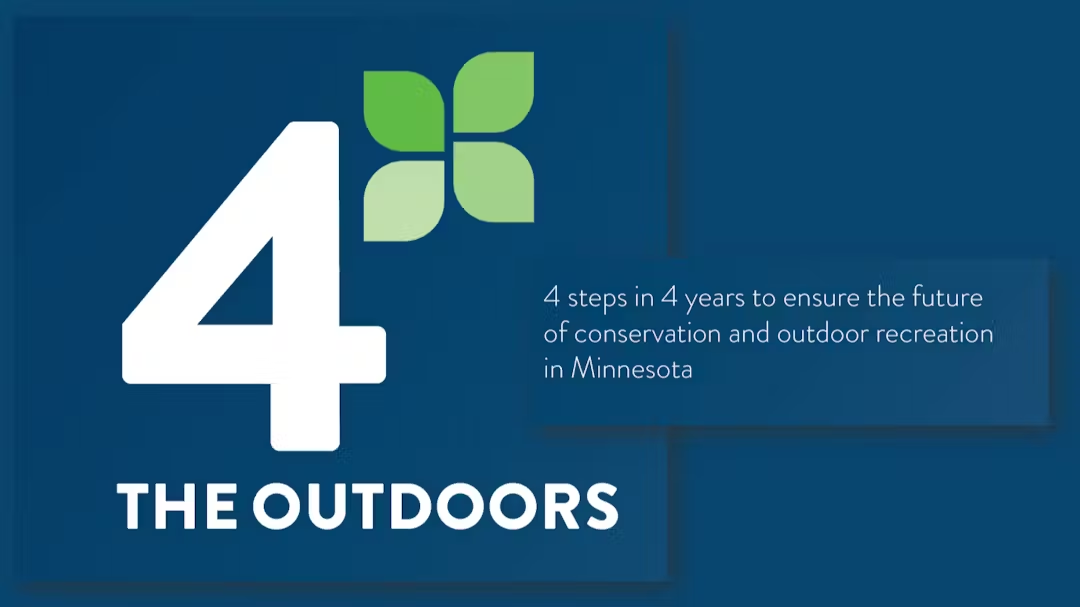The 2025 DNR Roundtable and the Future of Minnesota’s Waterways: A First-Timer’s View
By Sami Selter, MLR Associate Executive Director
The Minnesota Department of Natural Resources’ annual Roundtable is where leaders get an update on progress and discuss priorities for the year ahead. This year, I had my first opportunity to attend, as well as present as a panelist at Roundtable—an event that Minnesota Lakes and Rivers has been participating in since 2011.

Celebrating ENRTF: A Victory for Minnesota’s Natural Resources
The event’s opening centered on the successful ballot measure extending the state lottery amendment to fund the Environmental and Natural Resources Trust Fund (ENRTF), with 77% approval from Minnesotans. ENRTF has invested in many improvements to Minnesota’s natural resources. This funding, designated by the Legislative-Citizen Commission on Minnesota Resources (LCCMR), supported MLR’s Stop Starry Program, installing 30+ CD3 Waterless Cleaning stations statewide, equipping thousands of boaters to Clean, Drain, and Dry at infested lakes.
In the morning panels, the DNR presented on their key investments, including the $150 million dedicated to the Get Out MORE program. This initiative is improving access to public lands, modernizing camping and boating infrastructure, enhancing fisheries, and updating water-related infrastructure to support outdoor recreation, including accessible docks and updated boat accesses.

The DNR also provided updates on programming, including the first revision in 40 years of the Fisheries Lake Management Planning Guide.
Afternoon panels featured candid discussions on local initiatives, allowing for participant feedback. As a first-timer, I was eager to hear the questions from partners across the natural resources sector about Minnesota’s most pressing lake and river issues. However, I noticed a lack of focus on issues critical to lakefront communities, particularly aquatic invasive species (AIS), diminishing natural shoreline, and climate change’s impact on water quality. While attendees frequently asked about the DNR’s AIS management and there was a panel covering Invasive Carp, aquatic invasive plants and climate change received little attention.
“Right-Sizing” Fees for Future Natural Resource Management:

During my panel with 4 the Outdoors, I raised the need for AIS funding in the discussion on “Right-Sizing Fees.” The DNR’s 4 the Outdoors program is redesigning funding mechanisms and evaluating how user fees can better support natural resources. One key fee with proven local impact is the AIS surcharge on three-year boat registrations. Initially set at $5 for nearly 30 years, MLR and other advocates pushed for an increase to $25, but it was raised only to $10.60 in 2019. Now, proposals aim to bring it to $25. These funds support critical programs like the Invasive Aquatic Plant Management Grants, which help lake associations manage AIS. Yet, the current statewide grant pool is just $400,000—far short of the $8 million spent annually on AIS control.
The need for more robust funding is clear. DNR representatives on our panel acknowledged this and expressed interest in learning from leaders at the Roundtable about the AIS surcharge and other fees. Feedback focused on the immediate benefits recreators receive from fees, with suggestions such as custom license plates or lifetime hunting and fishing licenses for children under five. Others emphasized promoting existing revenue sources with more transparency to encourage participation. Some even advocated eliminating fees altogether—despite Minnesota’s historically low natural resource fees, which haven’t kept pace with inflation or increased environmental pressures.
With such varying opinions, I reflected on the core purpose of our discussion: advocating for “right-sizing” fees. But how do you “right-size” something with so many perspectives? The answer lies in remembering why these fees exist—to protect and preserve our natural resources for current and future generations.
Rising temperatures, fluctuating droughts, and severe floods are altering water quality, accelerating AIS spread, and threatening ecosystem resilience. Minnesota’s waters today are drastically different from 30 years ago, and future generations will experience them in new and uncertain ways. As we navigate these growing challenges, we must shift our focus from short-term personal benefits to long-term environmental stewardship.
While pushback is inevitable, the real question remains: How will we, as today’s stewards, ensure the protection of our natural resources for future generations? The answer is in viewing fees as long-term investments in the health of our lakes and rivers. With increasing resource use, rising pollution risks, and declining hunting and fishing license purchases, deficits and funding cuts are expected. By raising fees now and ensuring transparent, effective fund allocation, we can take meaningful steps to protect Minnesota’s waterways and landscapes for years to come.
Now is the time to prioritize lasting solutions, such as AIS prevention through initiatives like the $10 million annual AIS Prevention Aid to counties or an increase in the AIS surcharge. These investments will not only address immediate threats but will also save billions in future mitigation costs, ensuring Minnesota’s waters remain healthy and accessible for generations.
Local Leadership: The Driving Force Behind Environmental Progress
A recurring theme throughout the day at the Roundtable was “coalitions” and the power of collaboration. The future of our lakes and rivers depends on the choices we make today. Citizens like the members of lake associations that MLR represents are already making those choices—investing their own time, money, and civic power to tackle the urgent challenges facing our waters. If we want to build effective partnerships between state governments and citizens, local governments, lake associations, and their advocates must be central to those coalitions. They are the most informed, engaged, and ready to act.
The state must do better to ensure that the funds collected from Minnesotans are used to support organizations actively applying solutions and monitoring progress in ecological restoration. Without their daily dedication and local initiatives, we will quickly learn how vital these advocates are in meeting the mission of the DNR to “work with Minnesotans to conserve and manage the state’s natural resources, to provide outdoor recreation opportunities, and to provide for commercial uses of natural resources in a way that creates a sustainable quality of life.” By advocating for increased funding and transparent resource management, we can not only preserve Minnesota’s natural beauty but also strengthen the coalitions the DNR emphasized as critical to their mission.
Local leadership across sectors and counties played a key role in securing the success of the ENRTF ballot measure. Water connects us all—it’s part of our identity and legacy, something we can all agree is worth protecting. As Lt. Governor Peggy Flanagan put it, “We absolutely have our disagreements in politics these days, but I am thrilled to acknowledge and to know that we absolutely can agree on our shared values around clean air and clean water for all Minnesotans into the future.”
